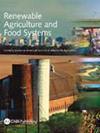全系统关联分析:基于洪水的生计系统中的水分配规则、农业生产力和生计
IF 2
3区 农林科学
Q2 AGRICULTURE, MULTIDISCIPLINARY
引用次数: 0
摘要
摘要基于洪水的生计系统(FBLS)中的水管理和分配规则在提高全系统生产力和生计方面发挥着关键作用。虽然巴基斯坦DG Khan FBLS在一定程度上利用了这种潜力,但肯尼亚和埃塞俄比亚的Tana河和Fogera FBLS尚未实现这一潜力。这三个系统被地方政府和社区视为各自地区水和粮食安全的主要来源。根据对巴基斯坦FBLS农民的105次个人采访,该论文确定,一套水管理和分配规则对(a)缓解上游洪水的过度使用,(b)减少下游缺水,以及(c)在上下游地区实现近4吨公顷的主要小麦作物收成做出了重大贡献。这一收益率比全国平均水平高出约20%,是可实现的最大收益率的三分之二。此外,86%的上游农民和四分之三的下游农民设法满足了他们的生计需求,包括医疗、学校、住房、交通、能源和食品费用。另一方面,根据分别对肯尼亚和埃塞俄比亚的94名和147名FBLS农民的个人采访进行的分析,揭示了缺乏全面的水管理和分配规则的负面后果。在肯尼亚,占塔纳河FBLS人口三分之二的下游小规模农民经常遭受洪水短缺的影响。他们无法种植高回报的水稻作物,其主要玉米产量较低,约为1.25吨公顷-1,是可达到的最高产量的20%。五分之四的人报告生计不佳。然而,上游的大规模农民经常转移过多的洪水;超过90%的人通常种植水稻和玉米作为家庭消费的第二作物。福格拉的情况也类似。水分配规则优先考虑了十年前为促进经济增长而引入的上游水稻种植。95%的受访农民表示,这导致下游洪水稀少,玉米减产约30%,生计恶化。这些关于配水规则影响的研究结果有助于制定投资,更好地实现非洲和全球FBLS的生产力和生计潜力。本文章由计算机程序翻译,如有差异,请以英文原文为准。
System-wide nexus analyses: water distribution rules, agricultural productivity and livelihoods in flood-based livelihood systems
Abstract Water management and distribution rules in flood-based livelihood systems (FBLS) have a key role in enhancing system-wide productivity and livelihoods. While such potential has to a certain extent been harnessed in DG Khan FBLS in Pakistan, it has not yet been fulfilled in the Tana River and Fogera FBLS in Kenya and Ethiopia, respectively. These three systems are considered among the major sources of water and food security in their respective regions by the local governments and communities. Drawing from 105 individual interviews with Pakistani FBLS farmers, the paper establishes that a package of water management and distribution rules have significantly contributed to (a) mitigating excessive upstream floodwater use, (b) reducing downstream water scarcity and (c) realizing nearly 4 tons ha−1 harvest of the major wheat crop across the upstream and downstream areas. This yield is about 20% higher than the country-wide average, and two-third of the maximum achievable. Furthermore, 86% of the upstream and three in four of the downstream farmers have managed to cover their livelihood needs that included health, school, housing, transportation, energy and food expenses. On the other hand, the analyses based on individual interviews with 94 and 147 FBLS farmers from Kenya and Ethiopia respectively, uncovered the negative consequences of the absence of a comprehensive package of water management and distribution rules. In Kenya, the downstream small-scale farmers that account for two-third of the Tana River FBLS population frequently suffer from floodwater scarcity. They could not cultivate the high return rice crop and their staple maize yield was low at about 1.25 tons ha−1 or 20% of the maximum attainable. Four in five reported poor livelihoods. The upstream large-scale farmers however often diverted excessive floodwater; over 90% usually grow rice as well as maize as a second crop for home consumption. The situation in Fogera is similar. The water distribution rules prioritized the upstream rice cultivation introduced a decade back to boost economic growth. This, as informed by 95% of the interviewed farmers, has caused downstream floodwater scarcity, about 30% maize yield reduction and livelihood deterioration. These findings on the impacts of water distribution rules can contribute to formulating investments that better achieve the productivity and livelihood potentials of FBLS across Africa and globally.
求助全文
通过发布文献求助,成功后即可免费获取论文全文。
去求助
来源期刊

Renewable Agriculture and Food Systems
农林科学-农业综合
CiteScore
5.20
自引率
7.40%
发文量
39
审稿时长
>36 weeks
期刊介绍:
Renewable Agriculture and Food Systems (formerly American Journal of Alternative Agriculture) is a multi-disciplinary journal which focuses on the science that underpins economically, environmentally, and socially sustainable approaches to agriculture and food production. The journal publishes original research and review articles on the economic, ecological, and environmental impacts of agriculture; the effective use of renewable resources and biodiversity in agro-ecosystems; and the technological and sociological implications of sustainable food systems. It also contains a discussion forum, which presents lively discussions on new and provocative topics.
 求助内容:
求助内容: 应助结果提醒方式:
应助结果提醒方式:


